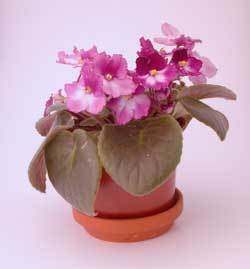
The African violet, one of America's most common houseplants, comes in an immense range of varieties. Although it is not difficult to grow, it does demand constant care and attention. Above all else, that is the secret to successfully growing and maintaining this diverse and beautiful plant.
There are three primary areas to consider concerning the health of African violets: light, food and water, and general environmental conditions. These houseplants can be extremely finicky when it comes to their care, and upsetting the environmental balance will result in poor plant health.
In order to bloom, African violets need quite a bit of light, more than most people first realize. Moderate light is best, with exposure to direct light for long periods causing damage. Northern and eastern exposures tend to give these plants adequate amounts of sun. If you're unable to capture enough natural light for your violets fluorescent tubes placed about 8 inches above the plants for 12-16 hours a day will enable flowering. If your plant is receiving inadequate light you'll see dark, lean, blue-green leaves with long petioles.
Attaining the right amount of light for your African violets can be tricky, but what is most difficult about caring for this plant is simply watering. The right balance is hard to find and maintain. Too little water and the plant won't grow or flower properly; too much water and the plant will often rot.
One method that works well is placing a saucer of water under the plant, allowing it to sub-irrigate. The plant will take water up through the bottom of the soil. If you use this method leave the plant in the water long enough to make the top inch of soil moist; remove the saucer and do not water again until that upper layer is dry. This will help guard against rotting.
It is also good practice to water these plants occasionally from the top; this will help leech out accumulated salts, which can harm the plant. When watering from above use water that is room temperature, otherwise cold water can damage the sensitive leaves, leading to an unhealthy situation.
Proper fertilization by using a complete fertilizer, which is dispensed at a low rate, is recommended. If over fertilized African violets will suffer from poor flowering, exposure to soil salts, and excessive growth.
Other general environmental conditions that influence the successful growth and flowering of your African violets include proper temperature, soil make-up, and problems associated with insects and disease.
Temperatures between 65 and 80 degrees F are ideal for African violets. Room and water temperatures below 50 degrees F will damage the leaves, causing them to wither and darken. Temperatures above 85 degrees F will result in poor plant and flower growth and dry, damaged leaves.
Soils that drain poorly and compact easily, such as garden or field soils, will not sustain African violets. Loose, porous soil with a pH level between 6.0-6.5 is vital to maintaining good growth. Pasteurized, fertile peat-based soils are recommended.
The good news is that if African violets are tended properly they rarely have trouble with disease or insects. Along with common problems such as mites and mealy bugs, these houseplants are susceptible to fungal disease brought about by the use of cold water on leaves and nighttime exposure of leaves to water. Over watering can also cause fungal problems. Once again, take care when watering these plants.
African violets demand daily care and the right conditions in order to thrive. Once you've created and maintained those conditions, you'll have a beautiful plant that will flower continuously throughout the year.

About The Author: Ellen Brown is our Green Living and Gardening Expert. Click here to ask Ellen a question! Ellen Brown is an environmental writer and photographer and the owner of Sustainable Media, an environmental media company that specializes in helping businesses and organizations promote eco-friendly products and services. Contact her on the web at http://www.sustainable-media.com
Add your voice! Click below to comment. ThriftyFun is powered by your wisdom!
I have my violets in a west window garden and they are doing so well, many many blooms but want to replant them.
Add your voice! Click below to comment. ThriftyFun is powered by your wisdom!